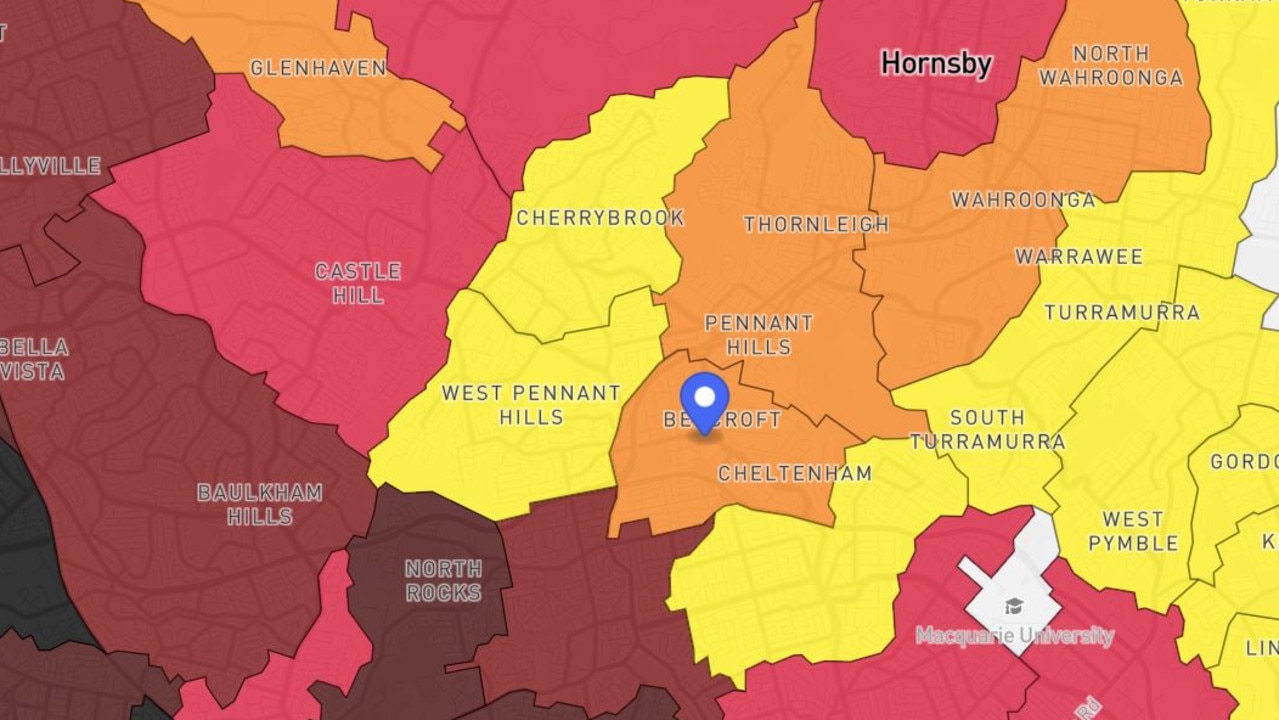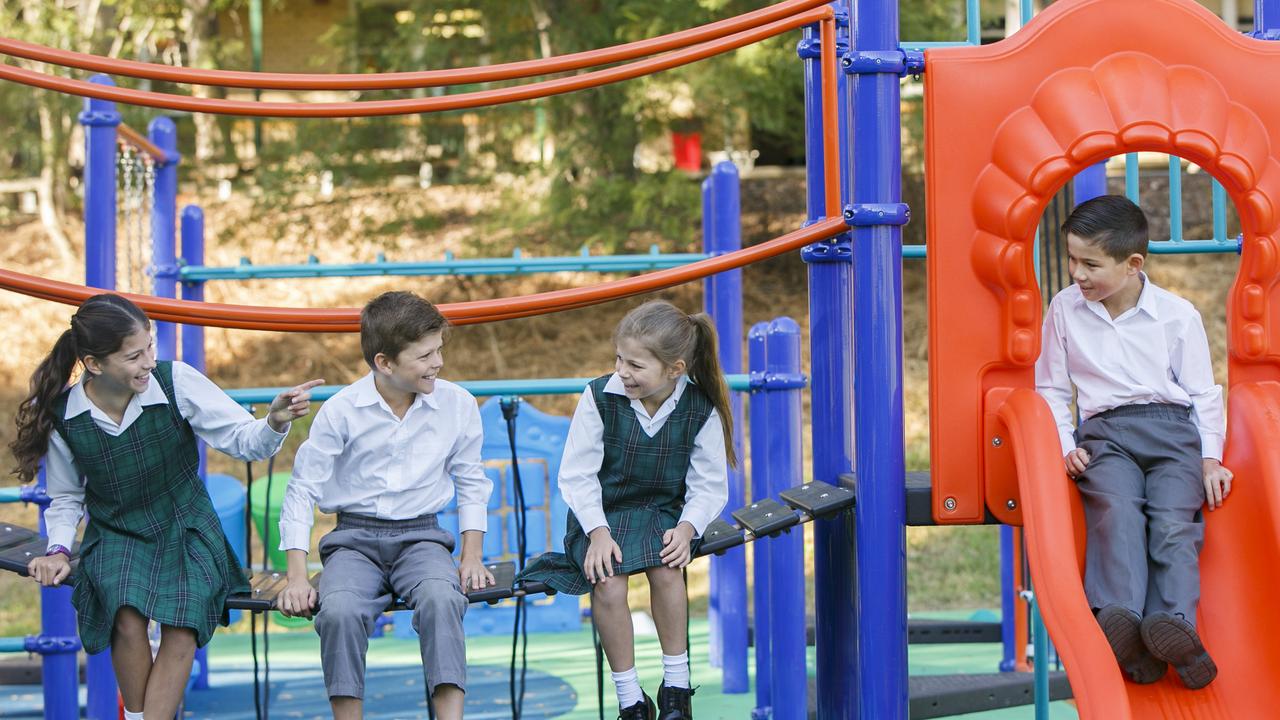Resident stuck on wrong side of Sydney suburb says Covid restrictions are ‘unfair’
Residents in the same Sydney suburb are living very different lives thanks to a change made years ago. No one thought it would make such a difference.

As reports swirl about NSW’s plans for opening up, the residents of some Sydney suburbs are concerned about being left behind due to an “unfair” situation.
For weeks the residents of three suburbs in Sydney’s north have been spilt in half, with those on one side of the M2 motorway suffering under stricter Covid-19 restrictions due to a border change.
Mother-of-two Stephanie* said the situation had developed after Parramatta local government area (LGA) was included as an area of concern, whose residents must live under tighter rules including a curfew and work restrictions.
While most people think of Parramatta as an area in Sydney’s west, the LGA also includes parts of what were previously part of the Hornsby and The Hills council areas prior to a 2016 amalgamation.
This includes parts of the suburbs Beecroft, North Rocks and Carlingford.
Stephanie lives in North Rocks and said it had been heartbreaking to live under the tougher restrictions.
“I think it is harsh, it’s horrendous what’s happening,” she said. “We all feel terrible and the community is being so compliant, everyone walks around with masks and I haven’t heard of any superspreading parties, it’s a very family orientated area.”
She points out that case numbers in neighbouring suburb Beecroft are lower than in the inner west suburb of Marrickville, which has not been included as an area of concern.
Marrickville was on Wednesday identified as one of four suburbs whose case numbers authorities were concerned about, along with Glebe, Waterloo and Redfern.
“I’d like to encourage the residents of those suburbs … to please come forward for vaccination,” NSW chief health officer Dr Kerry Chant told reporters.
The NSW Health website shows there have been a total of 82 cases in the 2204 postcode, which includes Marrickville, and there are 54 active cases.
In contrast there has only been 25 cases in the 2110 postcode covering Beecroft and Cheltenham, and only 13 active cases.
Despite this, some Beecroft residents who live on the south side of the M2, who are included in the Parramatta LGA, are living under harsher restrictions. Residents on the opposite side — considered part of Hornsby LGA — are not.

Similarly, parts of North Rocks and Carlingford are included in The Hills council area.
Stephanie’s home just happens to be in the part of North Rocks that is considered part of Parramatta LGA.
The Covid numbers in postcode 2151, which includes North Rocks but also parts of North Parramatta, Oatlands, Telopea and Dundas Valley, are higher at 125 cases, with 110 active, but Stephanie believes authorities will find few cases in North Rocks specifically.
“My biggest concern is that when Greater Sydney opens up we won’t, and our three suburbs will be left behind,” she said.
In the postcode of 2118, which includes Carlingford, the Covid numbers are similar to Marrickville, with 84 cases and 69 active.
Double standard is ‘not okay’
It’s becoming apparent to many residents that the division between areas will sharpen once restrictions begin to relax this month, with suggestions some LGAs may get even more freedoms in order to trial a new vaccine passport app.
Next week, all Sydneysiders will also be able to enjoy outdoor picnics but those in the 12 areas of concern won’t be able to meet up with those outside their household.
Stephanie said she won’t be able to meet up with other mums from her school community, something that those living on the other side of the M2 will be able to do.
“While my husband and I can sit outside together, our friends who live 200 metres way can meet with four different households, sit together and have a picnic or coffee,” she said.
“Even if it’s just me and one child, I can’t meet another mum and their child, just to ease the tension or for their mental health. This is really hard.
“It’s hard enough to see everyone in Bondi, and I understand they are allowed to go outside, but I can’t even go to a local park and sit near one of my children’s friends. It's devastating and God knows how long away we are from doing that.”
North Rocks Public School, which is located in the Parramatta LGA close to the M2, will also not be reopening from October 25.
“Our school is not opening up on 25th of October with every other school and that’s heartbreaking,” Stephanie said.
She said there would only be six weeks left of the school year anyway.
“If it doesn’t open up, our children would not have gone to school for two terms, but for what reason?”
“To have children not going to school here when they don’t have the data to support it, is just not okay.”

Stephanie believes that North Rocks, Beecroft and Carlingford are in a unique position as the suburbs are spilt across different LGAs, and the rules have left them in an “unfair” situation.
“We are very much on the border, and only due to a change of a few lines half a dozen years ago, that is impacting us so severely,” she said.
She said she knew business owners in Beecroft were also feeling concerned.
“In these areas of concern they’re not drilling down into suburbs,” she said.
“I’m hoping they will be fair and look at our unique situation and think, ‘this makes a lot of sense and it’s not fair’.”
Stephanie pointed out that only certain suburbs in Penrith were put under more strict restrictions rather than the entire LGA.
“All I’m asking is that they do review it and that it is fair,” she said. “Just look at the data. I don’t think these three suburbs need to be under those extra restrictions.”
Biggest challenge to allowing more freedoms
Residents have also raised questions about restrictions over Burwood LGA, which has only recorded 43 cases in the past four weeks, compared to 265 cases in Inner West LGA and 440 in the City of Sydney, which are not areas of concern.
Premier Gladys Berejiklian has previously said authorities were considering removing some LGAs as areas of concern. Burwood, Bayside and Georges River were considered likely options.
Asked when the areas of concern would be updated, Ms Berejiklian said Wednesday the areas were set based on the head of population and that some councils had smaller populations.
“You can’t do it on a case-by-case comparison,” she said.
She also noted that modelling showed the worst weeks in terms of case numbers were likely to be in the next week or so.
“We need to make sure that we don’t cause any major adjustment which will see a skyrocketing of cases,” she said.
Ms Berejiklian said there would be greater freedoms for everyone who had received a double dose of a Covid vaccine once 70 per cent of adults had been vaccinated.
“I’m extremely optimistic that at 70 per cent double dose everybody who is vaccinated will enjoy life much more freely than what we do today,” she said.
However, Ms Berejiklian did not say whether those living in areas of concern would get the same freedoms as those in other areas.
“Every day I ask the health team … is there anything we can do to ease the stress on our citizens but I can’t afford and we can’t afford to ignore the health advice,” she said.
“These are all complex decisions and, again, we make them to protect lives, not to be popular … I want to look back to make sure that every day we did our best to keep people out of hospital, to keep people alive.”
Melbourne University clinical epidemiologist Professor Nancy Baxter said changing rules so that certain suburbs could enjoy more freedoms within a particular LGA would make things more complex.
“Making it more complex will be more challenging to enforce but that is the road Sydney is going down,” she said.
She said Covid was pretty deeply embedded in Sydney and if restrictions were eased prior to areas having high rates of vaccination, cases would increase.
“We need to see a consistent reduction in hospitalisations and ICU admissions related to those LGAs of concern,” she said.
However, she said that some activities were low risk, such as allowing people to enjoy picnics outdoors.
“It’s worth seeing what happens with picnics and how much the public uses and abuses it,” she said.
“It’s worth seeing how things evolve and how much strain it puts on the system.”
* Name has been changed
charis.chang@news.com.au | @charischang2






